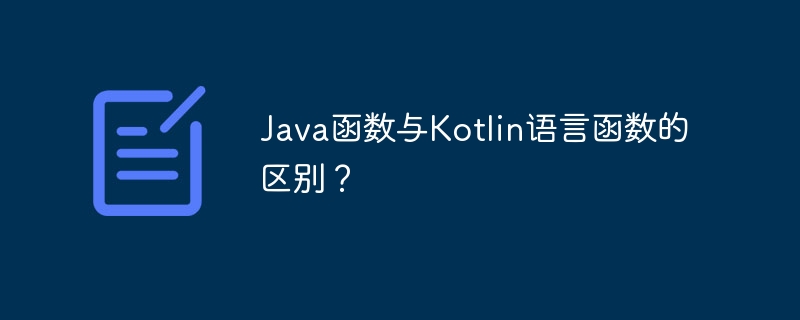What is the difference between Java functions and Kotlin language functions?
The difference between Java and Kotlin functions: Syntax: Java functions need to specify parameter types and names, while Kotlin can omit the type and use lambda expressions; Parameters: Kotlin can omit parameter types using a more concise syntax; Return value: Kotlin can Omit the return value type, which defaults to Unit; extension function: Kotlin can add new functions to existing classes, while Java needs to implement similar functions through inheritance; instance method call: Kotlin can omit the object name and use a more concise syntax.

The difference between Java functions and Kotlin language functions
Syntax:
- Java function:
public static void main(String[] args) - Kotlin function:
fun main(args: Array<string>)</string>
Parameters:
- Java function: parameter type and name need to be specified explicitly
- Kotlin function: parameter type can be omitted, parameter name is optional
Return value:
- Java function: the return value type must be specified
- Kotlin function: the return value type can be omitted ( Default is
Unit)
Lambda expression:
- Java: Need to implement the interface and override the method
- Kotlin: Use
{}directly to define lambda expressions
Example:
1 2 3 4 |
|
1 2 3 4 |
|
Extension function:
- Kotlin’s unique feature, you can add new functions to existing classes
- Java needs to inherit or use proxy classes to achieve similar functions
Instance method call:
- Java: via object name
.Method name - Kotlin: via object
.Method name (optional)
Practical case:
Consider a function that calculates the sum of two numbers:
1 2 3 4 |
|
1 2 |
|
In Java, you need to specify parameter types and names explicitly. But in Kotlin, you can omit parameter types and use a cleaner syntax. In addition, in Kotlin, you can add a plus function to the Int class through an extension function to make the code more readable:
1 |
|
In this way, you The sum of numbers can be calculated like this:
1 |
|
The above is the detailed content of What is the difference between Java functions and Kotlin language functions?. For more information, please follow other related articles on the PHP Chinese website!

Hot AI Tools

Undresser.AI Undress
AI-powered app for creating realistic nude photos

AI Clothes Remover
Online AI tool for removing clothes from photos.

Undress AI Tool
Undress images for free

Clothoff.io
AI clothes remover

AI Hentai Generator
Generate AI Hentai for free.

Hot Article

Hot Tools

Notepad++7.3.1
Easy-to-use and free code editor

SublimeText3 Chinese version
Chinese version, very easy to use

Zend Studio 13.0.1
Powerful PHP integrated development environment

Dreamweaver CS6
Visual web development tools

SublimeText3 Mac version
God-level code editing software (SublimeText3)

Hot Topics
 1378
1378
 52
52
 Perfect Number in Java
Aug 30, 2024 pm 04:28 PM
Perfect Number in Java
Aug 30, 2024 pm 04:28 PM
Guide to Perfect Number in Java. Here we discuss the Definition, How to check Perfect number in Java?, examples with code implementation.
 Random Number Generator in Java
Aug 30, 2024 pm 04:27 PM
Random Number Generator in Java
Aug 30, 2024 pm 04:27 PM
Guide to Random Number Generator in Java. Here we discuss Functions in Java with examples and two different Generators with ther examples.
 Weka in Java
Aug 30, 2024 pm 04:28 PM
Weka in Java
Aug 30, 2024 pm 04:28 PM
Guide to Weka in Java. Here we discuss the Introduction, how to use weka java, the type of platform, and advantages with examples.
 Smith Number in Java
Aug 30, 2024 pm 04:28 PM
Smith Number in Java
Aug 30, 2024 pm 04:28 PM
Guide to Smith Number in Java. Here we discuss the Definition, How to check smith number in Java? example with code implementation.
 Java Spring Interview Questions
Aug 30, 2024 pm 04:29 PM
Java Spring Interview Questions
Aug 30, 2024 pm 04:29 PM
In this article, we have kept the most asked Java Spring Interview Questions with their detailed answers. So that you can crack the interview.
 Break or return from Java 8 stream forEach?
Feb 07, 2025 pm 12:09 PM
Break or return from Java 8 stream forEach?
Feb 07, 2025 pm 12:09 PM
Java 8 introduces the Stream API, providing a powerful and expressive way to process data collections. However, a common question when using Stream is: How to break or return from a forEach operation? Traditional loops allow for early interruption or return, but Stream's forEach method does not directly support this method. This article will explain the reasons and explore alternative methods for implementing premature termination in Stream processing systems. Further reading: Java Stream API improvements Understand Stream forEach The forEach method is a terminal operation that performs one operation on each element in the Stream. Its design intention is
 TimeStamp to Date in Java
Aug 30, 2024 pm 04:28 PM
TimeStamp to Date in Java
Aug 30, 2024 pm 04:28 PM
Guide to TimeStamp to Date in Java. Here we also discuss the introduction and how to convert timestamp to date in java along with examples.
 Java Program to Find the Volume of Capsule
Feb 07, 2025 am 11:37 AM
Java Program to Find the Volume of Capsule
Feb 07, 2025 am 11:37 AM
Capsules are three-dimensional geometric figures, composed of a cylinder and a hemisphere at both ends. The volume of the capsule can be calculated by adding the volume of the cylinder and the volume of the hemisphere at both ends. This tutorial will discuss how to calculate the volume of a given capsule in Java using different methods. Capsule volume formula The formula for capsule volume is as follows: Capsule volume = Cylindrical volume Volume Two hemisphere volume in, r: The radius of the hemisphere. h: The height of the cylinder (excluding the hemisphere). Example 1 enter Radius = 5 units Height = 10 units Output Volume = 1570.8 cubic units explain Calculate volume using formula: Volume = π × r2 × h (4




